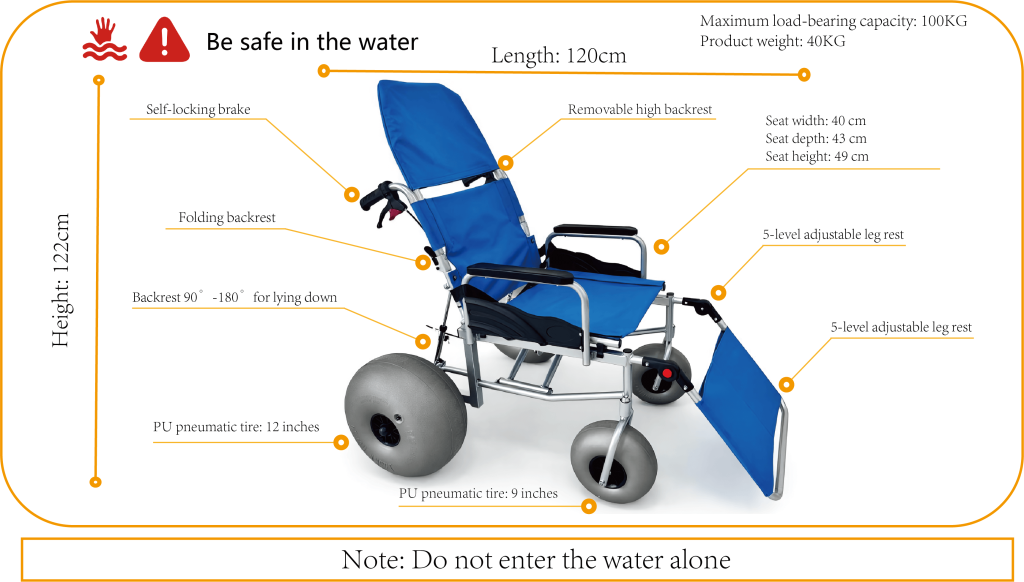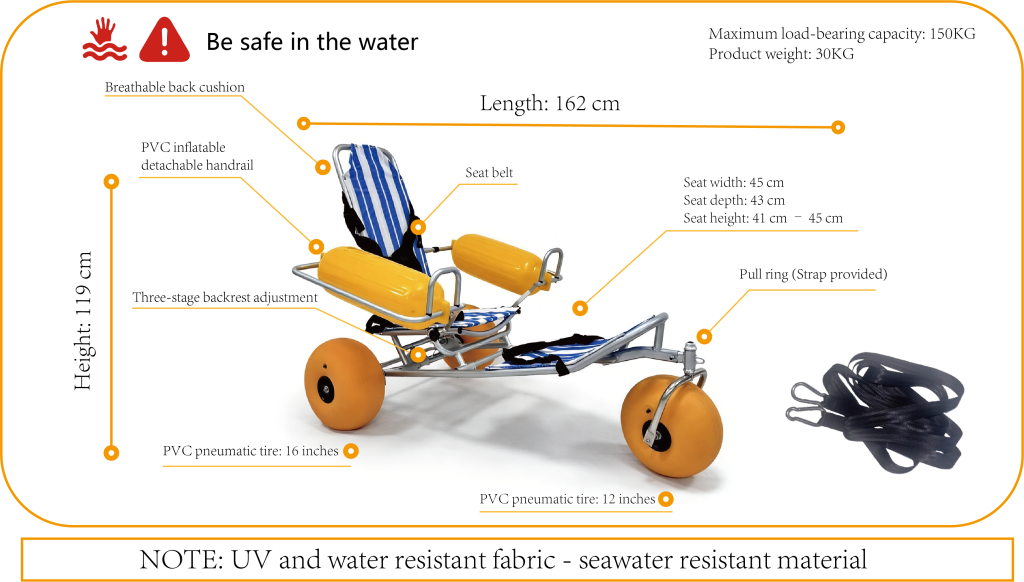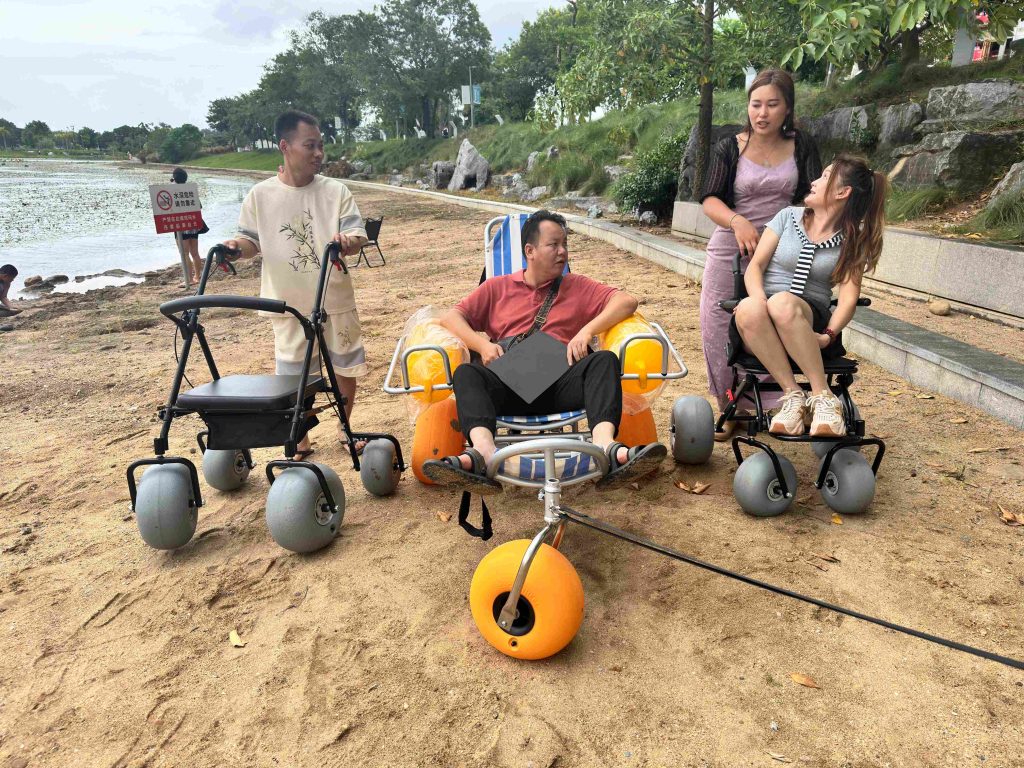The sun glints off the water. The shoreline beckons. For most, it’s paradise found. For others, it remains an impassable frontier. You have the power to change that narrative.
But a crucial decision stands between you and offering true beach freedom: the stalwart, all-terrain sand conqueror versus the revolutionary, amphibious water-lover. It’s a classic dichotomy. Do you invest in the rugged beast that glides over deep sand and challenging dunes, or the ingenious marvel that carries guests from the shore right into the gentle embrace of the waves?
This choice goes beyond mere mechanics. It’s a pivotal decision that will shape your guest satisfaction, define your operational workflow, and ultimately, impact your bottom line. Choosing wrong can be a costly misstep. Choosing right? That elevates your brand to a new echelon of inclusivity. Let’s navigate this sandy conundrum together and find the perfect fit for your world.
The Quick Lowdown: Your 30-Second Guide
Busy day? Here’s the essential takeaway. All-Terrain chairs are your workhorses for mastering deep, soft sand, making your entire beachfront accessible. Floating chairs are your showstoppers, offering the unforgettable experience of moving from sand directly into the water. Your choice depends on whether your primary goal is land access or a unique water-based adventure.
At a Glance: Floating vs. All-Terrain


To make this even clearer, let’s break it down. I’ve found that a side-by-side comparison helps procurement managers and facility coordinators see the distinct advantages of each model instantly.
| Feature | All-Terrain Beach Wheelchair | Floating Beach Wheelchair (Amphibious) |
|---|---|---|
| Primary Use | Traversing deep sand, dunes, and uneven terrain. | Sand-to-surf mobility; floating in calm water. |
| Key Feature | Large, low-pressure balloon wheels that glide over sand. | Floating armrests and pontoons for buoyancy. |
| Best For | Facilities with long, wide beaches or varied terrain. | Venues wanting to offer a unique aquatic experience. |
| Terrain Mastery | Excellent on dry and packed sand, gravel, and turf. | Good on sand; exceptional in water. |
| Water Capability | Not designed for submersion or floating. | Can be wheeled into the water and floats safely. |
| Ideal User | Guests who want to relax near the water, attend beach events, or navigate the shoreline. | Guests who desire the therapeutic or recreational sensation of being in the water. |
| Business Case | Guarantees access to the beach. A foundational piece of beach access equipment. | Provides a unique experience on and in the water. A major driver of customer satisfaction. |
Now that you’ve got the overview, let’s get into the specifics. As a manufacturer, I’ve seen firsthand how these differences play out in real-world scenarios, and the details are what truly determine the best fit.
Let’s Dive Deeper: What’s the Real Difference?
On the surface, both chairs look similar. They both feature large wheels and durable frames designed for harsh beach environments. But their core philosophies are fundamentally different. One is about conquering the land; the other is about embracing the water.
This isn’t just a product feature; it’s about the kind of experience you want to offer. Are you providing a path to the ocean, or are you providing the ocean itself?
Meet the All-Terrain Beach Wheelchair: The Undisputed Sand Master
Imagine a guest arriving at your beach. Between them and the beautiful shoreline is 100 feet of deep, soft sand—an impassable barrier for a standard wheelchair. The all-terrain beach wheelchair is the solution. I like to call it the sand master for a reason.Its magic lies in its signature large flotation tires. These oversized, low-pressure
balloon wheels, typically made of soft polyurethane, are designed to distribute weight over a wide area. Instead of digging into the sand, they glide effortlessly across it. Think of it like a snowshoe for the beach. This is the definitive wheelchair for traversing deep sand.
Key characteristics include:
- Superior Sand Mobility: Its primary function is to make navigating long stretches of sand feel easy. It’s the most reliable form of beach mobility solution for pure land access.
- Durable Construction: These chairs are built to withstand the elements. Look for a corrosion-resistant frame, often made from high-quality marine-grade aluminum or stainless steel, to prevent rust and degradation from salt and sun.
- Versatility on Land: While it’s a sand wheelchair, its utility doesn’t end there. The balloon wheels are also effective on gravel paths, lawns, and even snow, making it a versatile piece of adaptive recreation equipment for parks and recreation departments.
For a hotel facility manager, an all-terrain chair is a statement that your property is truly accessible. It says, “Our entire beach is open to you.”
Meet the Floating Beach Wheelchair: Your Amphibious Ace
Now, let’s talk about the game-changer: the floating beach wheelchair. This is more than just a chair; it’s an experience. This am phibious beach chair does everything the all-terrain chair does on the sand, but with one incredible bonus: it floats.
This amphibious mobility device allows a user to be wheeled across the sand, down the ramp, and directly into the ocean, lake, or pool. Specially designed floating armrests and, on some models, pontoon attachments provide stability and buoyancy, allowing the user to recline and float safely in the water. It’s a true sand-to-surf mobility solution.
As an OEM beach wheelchair manufacturer, we’ve seen demand for these skyrocket. It’s not just about mobility; it’s about inclusion in the ultimate beach activity.
Key characteristics include:
- Aquatic Access: The ability to enter and enjoy the water is its defining feature. It’s a water wheelchair and surf chair rolled into one.
- Safety First Design: These chairs are engineered for stability in the water. Features like safety harnesses and anti-tip designs are standard. The materials are, of course, completely waterproof and corrosion-resistant.
- Unforgettable Experience: For guests with mobility challenges, the sensation of floating freely in the ocean can be a profound, even life-changing, experience. This is a massive driver for enhancing guest experience and a powerful marketing tool for inclusive tourism.
If you’re looking to create “wow” moments that guests will talk about for years, the
aquatic wheelchair is your ace in the hole.
Who Are You Buying For? Matching the Chair to the User

Before you make a decision, you have to ask the most important question: who is this for? Understanding your end-users—whether they are hotel guests, rental customers, or members of the public—is critical.
The Adventure-Seeker vs. The Water-Lover: Decoding Customer Desires
I’ve worked with distributors across the globe, from the UK to the UAE, and I’ve learned that customer desires vary.
- The Beachcomber/Sunbather: This user simply wants to get to a spot near the water’s edge to relax, read a book, and enjoy the ambiance with their family. For them, an all-terrain beach wheelchair is perfect. It provides the access they need without unnecessary complexity.
- The Aquatic Enthusiast: This user yearns for the therapeutic and recreational feel of the water. They don’t just want to be near the ocean; they want to be in it. For this person, only a floating beach wheelchair will do. It offers an unparalleled level of participation and joy.
Offering both can be a fantastic strategy for a rental business looking to cater to all needs and maximize theirexpanding rental inventory.
Mobility Levels Matter: Key Comfort and Support Considerations
When procuring durable medical equipment (DME) for beaches, you must consider varying levels of mobility.
- User Comfort and Support: Look for chairs with comfortable seating, adequate back support, and options for headrests or lateral supports. Some users may need to be in the chair for extended periods.
- Transfers: How easy is it for a user to transfer into and out of the chair? Features like swing-away armrests can make a huge difference.
- Safety Features: For floating models, in particular, safety is paramount. Ensure the chair has robust safety harnesses and has been tested for stability in various water conditions. A chair with CE certification and ISO 13485 compliance demonstrates a commitment to safety and quality.
The Business Angle: Which Chair Drives Value for Your Venue?
As a procurement manager or business owner, your decision hinges on cost-effectiveness,long-term value, and return on investment. Let’s analyze this from the perspective of different business types.
For Beachfront Hotels & Resorts: Elevating the Guest Experience
For you, it’s all about creating a premium, inclusive atmosphere. A guest’s inability to access the beach is a major service failure.
- All-Terrain: This is your baseline for accessible hospitality. Having one or two available ensures no guest is ever excluded from your primary amenity—the beach. It’s a key part of achieving universal access solutions.
- Floating: This is your luxury upgrade. Offering an amphibious beach chair creates a signature experience that sets you apart. It’s a powerful marketing tool that demonstrates a commitment to inclusive tourism beyond the basics. This can become a huge competitive advantage for resorts and a driver of 5-star reviews.
For Rental Companies: Thinking About Durability, Maintenance, and ROI
Your world revolves around numbers: rental fees, uptime, and durability and maintenance costs.
- Durability is King: You need equipment that can handle heavy use and abuse. Look for chairs with a robust marine-grade aluminum or stainless steel beach chair frame. We’ve found that a well-built aluminum frame offers the best balance of strength, weight, and corrosion resistance. PVC frames can be lighter and cheaper, but may not offer the same long-term durability for a high-volume beach wheelchair rental business.
- ROI Calculation: Floating chairs can often command a higher rental fee due to their unique functionality, potentially leading to a faster ROI for rental equipment. However, all-terrain chairs may appeal to a broader customer base. Managing a rental fleet effectively often means offering both to capture the entire market.
- Seasonal Demand: Consider the seasonal demand for mobility aids. Offering a diverse inventory ensures you’re prepared for the summer rush.
For Public Parks & Accessible Beaches: Prioritizing Safety and Inclusivity
As a manager of a public facility, your mandate is clear: provide safe and equitable access for all.
- ADA Compliance: While ADA compliance for beaches doesn’t always mandate providing chairs, offering them is a huge step toward true accessibility. Beach access pathways (like Mobi-Mats) combined with all-terrain chairs create a truly accessible environment.
- Safety and Simplicity: For public use, simplicity is often best. An all-terrain model is intuitive and requires less supervision than a floating model. Your primary goal is ensuring everyone can get to the water’s edge safely.
- Community Impact: Providing this equipment fosters a sense of community and ensures that family and friends of all abilities can enjoy public resources together. It’s a powerful statement of safety and inclusivity.
Under the Hood: A Distributor’s Guide to Materials and Design
For a mobility equipment distributor or a discerning procurement manager for mobility aids, the devil is in the details. You need to know what you’re buying. As a factory with years of experience, these are the things I tell my partners to scrutinize.
The Great Wheel Debate: Balloon Tires vs. Other All-Terrain Options
The wheels are the single most important component. While balloon wheels made of polyurethane are the gold standard for soft sand, you may see other options. Harder plastic wheels may work on firm, packed sand but will struggle in deep, loose sand. When I’m talking to a client, I always emphasize that for true all-terrain performance, there’s no substitute for high-quality, low-pressure polyurethane wheels. They are the core technology behind a functional sand wheelchair.
Frame Materials Showdown: Aluminum, Stainless Steel, and Why It Matters
The frame is the backbone of the chair. It needs to be strong and, crucially, resist saltwater corrosion.
- Marine-Grade Aluminum: This is often the best choice. It’s lightweight, incredibly strong, and naturally resistant to corrosion. It offers the best long-term value.
- Stainless Steel: A stainless steel beach chair is also very durable and corrosion-resistant, but it’s significantly heavier than aluminum. This can make the chair more difficult to push and transport.
- PVC: A PVC wheelchair frame is the lightest and most affordable option. However, it may lack the rigidity and long-term durability needed for heavy commercial or rental use. It’s better suited for personal, light-duty applications.
When assessing a product, ask about the grade of the material and the quality of the welds. This is where manufacturing quality really shows.
Beyond the Chair: Logistics and Partnership Considerations
Your purchase decision doesn’t end with the product specs. As a global supplier, we know that partnership and logistics are just as critical to your success.
Why Finding a True Manufacturing Partner is a Game-Changer
You’re not just buying a chair; you’re entering a relationship. As a seasoned procurement manager like David Thompson would know, a reliable supplier is worth their weight in gold. You need more than a trader; you need a manufacturing partner.A factory-direct partner like us (Ary Medical) offers:
- Supply Chain Reliability: No middlemen. You get consistent production and stable sourcing.
- Customization: Need a specific color, branding, or feature? An OEM beach wheelchair manufacturer can work with you to develop custom mobility solutions.
- Direct Communication: When you have a question or need support, you’re talking directly to the people who designed and built the product.
Navigating Compliance and Certifications (A Non-Negotiable)
For medical and mobility equipment, compliance is not optional. Your reputation and your customers’ safety depend on it. Ensure your supplier can provide documentation for:
- ISO 13485: The international standard for medical device quality management systems.
- CE Certification: Required for products sold within the European Economic Area, indicating conformity with health, safety, and environmental protection standards.
- FDA Compliance: Necessary for selling medical devices in the United States.
A supplier that readily provides these certifications is a supplier you can trust. It’s a clear sign they are serious about quality, not just cutting costs.
Assembly, Storage, and Shipping: The Practical Details That Affect Your Bottom Line
Finally, think about the practicalities.
- Storage and Assembly: How easily does the chair break down for storage during the off-season? A chair that is easy to assemble and disassemble saves you time and labor.
- Weight Capacity: Ensure the chair’s weight capacity meets the needs of your expected user base.
- Logistics and Shipping: Work with a partner who understands international logistics and shipping. Reliable delivery times and secure packaging are essential for keeping your operations running smoothly.
Making Your Final Call: It’s About More Than Just a Chair
So, the rugged all-terrain workhorse or the revolutionary amphibious marvel?
The choice, as we’ve seen, is deeply strategic. It’s not about picking the “best” chair, but about picking the right chair for your specific goals, your clientele, and your operational reality.
- Choose the All-Terrain Beach Wheelchair if your primary goal is to guarantee reliable, safe access across your entire sandy property. It’s the foundational building block of an accessible beach.
- Choose the Floating Beach Wheelchair if your goal is to offer a premium, unforgettable aquatic experience that will generate buzz, delight guests, and set your facility apart from the competition.
Many of our most successful partners—from resorts in the Maldives to rental shops in California—have found that the ultimate solution is to offer both. This allows them to meet every need, maximize their revenue, and cement their reputation as leaders in
accessible beach tourism.
Ultimately, you’re not just buying a piece of equipment. You’re investing in inclusivity, customer satisfaction, and the simple, profound joy of a day at the beach.
I hope this detailed guide has helped clarify your decision. If you have more questions about product specifications or finding the right manufacturing partner for your mobility needs, feel free to reach out. We’re here to help you make every shoreline accessible to everyone.
